Forty-six years ago, in July 1969, the Rolling Stones took to the stage for a concert in Hyde Park. It was two days after the death of guitarist Brian Jones and thousands of young fans flocked to see them. The gig was dedicated to Jones, and Mick Jagger read from Andonais, a poem Shelley wrote about the loss of his friend John Keats. What did Jagger, arguably then the figurehead of youth culture, wear for this poignant moment? A white, frilled dress with a pie crust collar covered with bows.
Ever since Elvis wore eyeliner, men in rock have enjoyed a bit of dressing up and challenging the cultural idea of masculinity. Some of the most iconic men in pop – David Bowie, Marc Bolan, Jimi Hendrix – ruled rock’s airwaves done up to the nines in frilled blouses, glitter makeup, brocade, high heels and feather boas. They even had their own designers – Bowie worked with Michael Fish, creator of what became known n as “the man dress” and the designer of Jagger’s 1969 number. The subversiveness of all this only added to their allure, their air of transgression and all-round swagger.
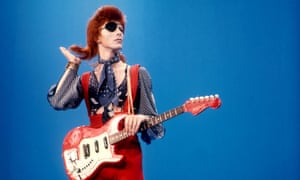
While Springsteen’s leather jacket and Status Quo’s denim are a vital blue-collar, who-cares-about-fashion, macho vision of masculinity in rock, it’s the gender-playing, androgynous aesthetic menswear designers are studying now. Today’s catwalks show styles typically associated with womenswear, only this time worn with stubble and a slouch and an unmistakable masculine attitude.
Take Gucci. This season is the debut outing for new designer Alessandro Michele. Although he had worked with the previous creative director, Frida Giannini, for more than 10 years, his image of men is light years away from hers. Her last Gucci menswear show was all nautical, jet set, grown-up and 100% masculine. His first show, for autumn/winter 2015, began with a boy with long blond hair in a red pussy-bow blouse and continued with sheer lace T-shirts, capes and lots more blouses. What a difference a season makes.
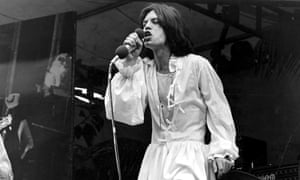
It wasn’t just Gucci who put their weight behind this new, more flamboyant ideal of man. Balmain’s models wore jackets made of sparkly jewels over their polonecks, Givenchy and Dries Van Noten had kilts and patterned, embellished blouses, while Haider Ackermann created a band of boys in louche leopard-print coats, stringy silk scarves and chelsea boots. JW Anderson – always a disrupter when it comes to gender and fashion – had boys in tight leather, skinny knitwear and bootleg trousers worthy of Prince.
Then there’s Hedi Slimane’s Saint Laurent. Since he became creative director in 2012, the brand has been a greatest hits of rock’n’roll fashion. Musicians rather than models were cast for this season’s catwalk shows; boys – skinny as rakes, with that signature Slimane-approved swagger – in shocking pink fur coats, leather trousers, mesh tops, eyeliner and heels as high as those of the girls who sometimes joined them on the catwalk
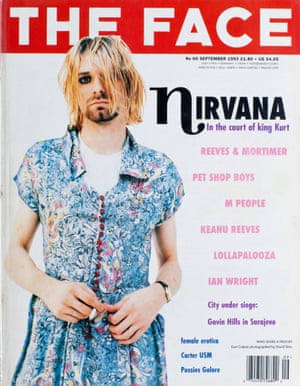
Damien Paul, head of menswear at matchesfashion, links this trend to “a reaction against the sports-influenced look that has been dominant for the last few years and no longer feels impactful. Now it feels much more subversive to channel an androgynous look.”
It’s a subversion that, ironically, has been missing from music of late. A quick scan of the charts shows that – just as in the pre-glam era – being a regular guy is the thing. There’s the buttoned-up, Sinatra-influenced smartness of Mark Ronson, the T-shirts and jeans of Years & Years, and the hats and hair combo of singer-songwriter types such as James Bay. The likes of Kanye West wearing a Givenchy kilt, Kid Cudi in a crop top at last year’s Coachella festival or rapper Lil B wearing chandelier earrings this summer are few and far between in pop. West, hardly conservative when it comes to clothes, even apparently tried to remove images of himself wearing the kilt from photography agency Getty after negative press online.
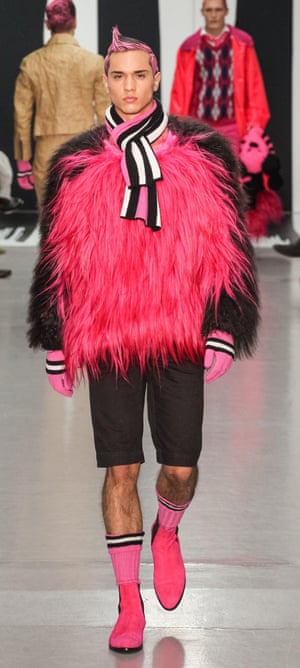
Paul Gorman, fashion curator and author of The Look, a book about rock and pop fashion, says: “Young people have become more conservative in the last 20 years and they’re kind of anti this stuff [androgyny in rock stars]. In the 80s, we could afford to experiment; that might not be the case for the post-recession generation.”
But if contemporary rock culture has become risk-averse, the same cannot be said of fashion. A rock star’s take on androgyny – let’s call it the rock androgyne – is back on the catwalk, and the moodboard potential is vast. It runs from Little Richard and his eyeliner to the Stones and Jagger’s dresses, Prince’s pants-plus-stockings Dirty Mind look, Manic Street Preacher Richey Edwards’ fur coats, Kurt Cobain’s tea dresses and the blouses that Suede’s Brett Anderson and Pulp’s Jarvis Cocker picked up in the women’s section of their local charity shops. Cozette McCreery, one of the designers behind London brand Sibling, namechecks Keith Richards and Billy Idol as moodboard favourites. She says it’s charisma that’s the secret ingredient, the thing that draws creatives. “The best musicians have a, ‘Hi, I’m here and you have to notice me’ attitude. I grew up in the 80s when [hair metal] rock stars had better hair than the women and wore Lycra onesies, but they still had groupies. If you have the confidence, it works.”
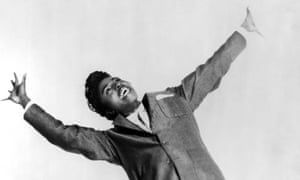
The last time we saw this very masculine appropriation of women’s clothes was in the 90s, when Edwards, in a skewed version of Rita Tushingham, adopted leopard-print fur coats and eyeliner, and Cobain wore a dress on the cover of The Face. The fact that the 90s is a decade enjoying a bit of a revival across culture – see everything from the return of TFI Friday to our screens to Kickers being fashionable and Ride reforming – has a part to play in this trend, and affects the way it’s playing out.
Indie stars of the era – Anderson, Edwards, Cobain, as well as Cocker and Placebo’s Brian Molko – brought a downbeat quality to the look, different from the otherworldliness of glam rock, or the hairspray’n’tan of 80s rock. Adding irony by mixing women’s clothes with stereotypically manly things such as a beard (Cobain) or a beer (Edwards) brought a punk kind of subversion. Using clothes to play with gender in this way isn’t just about looking pretty: it’s highlighting the edges of society, celebrating outsiders and questioning norms. Speaking on the BBC 4 documentary When Pop Ruled My Life, Manics’ bassist Nicky Wire remembered the band’s style “appealing to a lot of kids, to look different and be different”. Pop culture critic and music writer Simon Reynolds, who is working on a book about glam rock, agrees. Cobain in a dress, he says – one of the most iconic images of the decade – was “about him saying, ‘I’m with the outcasts.’”
It is that feel that current menswear revives. Givenchy’s men in button-through skirts and Gucci’s blouses provide a powerful contrast to the buttoned-up, tidy sportswear men have worn for the past five years. As Gucci designer Michele said after his spring/summer 2016 show in June, “Masculinity was about beauty and that you could interpret that how you wanted.” Givenchy’s Riccardo Tisci has expressed similar sentiments: “We [fashion designers] don’t have a huge power but maybe we can make people think. To me, beauty is beauty.”

The rock androgyne is also very bound up with British menswear – as much as the tradition of tailoring and suits on Savile Row. Dylan Jones, editor of GQ magazine, says, “We’re good at tradition and rebellion, and those two strands make interesting juxtapositions.” Jones, who has been “obsessed with Bowie from the age of 12”, says that this look coming from fashion rather than rock is a sign of how style is becoming more important to men. “Fashion has never been so omnipresent. Men are more open to things. The rock look has become a staple because, unlike a lot of fashion cliches, it gets stronger as the years go on. There’s a cycle of reinvention.”

For today’s young men, the pomp of rock is light years away, but the fascination with the look remains. Archive images are catnip on Instagram, where anything seen as retro or old school will immediately gain more likes. Gordon Richardson, the design director of Topman, chose to look at these references for the Topman Design show for autumn/winter, mixing the 90s and the 70s – a sure sign that the twentysomethings who shop in the high street store may soon be wearing shaggy fur jackets, flares and wedge haircuts. “There’s a nostalgia for fashion in its freest form. Conformity was broken down in the 70s,” Richardson says. “For our consumer it can feel new because they have none of those references. They just like it from a fashion point of view.”
But will rock’s men wear fur coats, eyeliner and high heels again? The jury’s still out. Harry Koisser, the 24-year-old frontman of Peace, who wore skirt suits in the video for their track World Pleasure, is frustrated by the rock landscape where “90% of bands look the same”, but he says there may be hope in their audiences. “We have just done a tour around the UK and noticed that more kids are dressing in a flamboyant way. There are more 16-year-olds in fur coats and eyeliner than when I was growing up and everyone wore sportswear. I like to think it’s possible we might influence a kid in Stoke to wear a coat to college.”
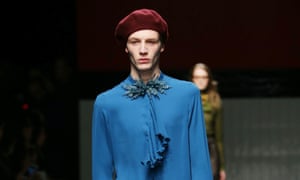
Paul at matchesfashion says that it will take time, but this is a trend that has legs. “When skinny jeans were first shown, they seemed incredibly radical,” he says, “but before long everybody was in them. Men are being edged towards a more daring approach to clothes. It’s exciting.” The timing may be right for this new view of masculinity – and it may come back to that very rock’n’roll thing: rebellion.
“Fashion and youth culture always play with ambiguity, and it breaks through about once a decade,” Gorman says. “It’s about pissing off the older generation as much as possible.” On the catwalk at least, that mission may have been accomplished.
Comments
Post a Comment